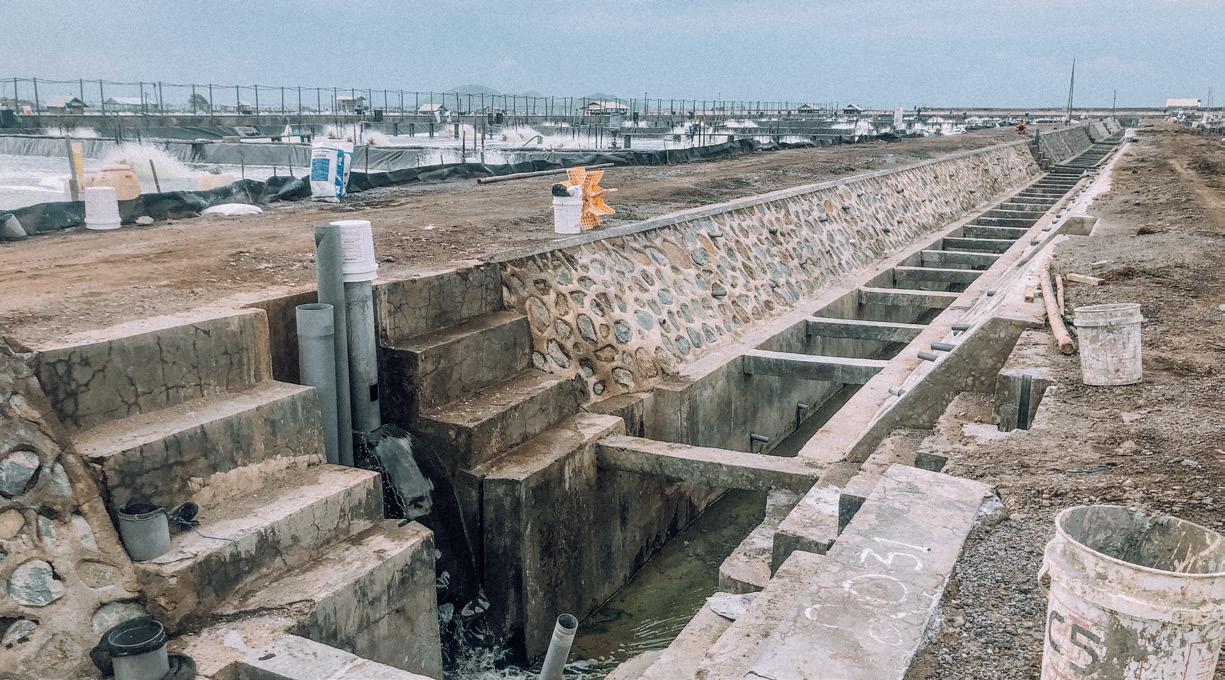
2 minute read
School Fish Growout Ponds
from THE CRUST - ISSUE #4
by THE CRUST
Aquaculture is different in many ways from agriculture. In aquaculture, we are dealing with biota that lives in a significantly different ecosystem than us. This presents more challenge than rearing terrestrial animals which live and breathes the same air as humans. So instead of the animal directly, aquaculturists usually focus on how to take care of the water quality so the animals inside can flourish.
Removing excess from the pond is one of the most important parts of aquaculture. The nutrient build-up due to various inputs such as feed can be dangerous to the stock if not taken care of. In conventional ponds, waste removal is achieved by sloping the pond floor toward the center where the central drain is located; while designing the paddlewheel placement to create a vortex that will bring all of the sludge to the center. One detail that is sometimes overlooked is that not all waste sinks to the bottom. Some types of waste float on the surface or near it such as dead plankton, hence it is best to equip the pond with a way to remove this floating debris. A way farmers do this is by installing a pipe near the side of the pond with a hole near the maximum water level of the pond that connects to the outlet channel. This way the waste can just be removed by the pond operator by pushing it through the opening.
In a recirculating aquaculture system (RAS), the effluent is not discharged but treated to be circulated back into the farm. The waste is removed from the pond the same way as normal farms, but in this system pieces of equipment for waste removal are installed to improve water quality. Generally, RAS needs to have the equipment to filter big particulates, bioreactors to convert harmful molecules, degassing equipment to remove nitrogen, and finally sterilization.
Most of the animals that we cultivate need oxygen to survive. In an aquaculture setting, oxygen is represented by the amount of diluted oxygen (DO) in the water. Hypoxic situations in the pond will not just hinder the growth of the animals but can also result in death. Our animal stock thrives in conditions where the oxygen supply is high. However, there is a certain limit to the level of oxygen as oxygen can be poisonous in hyperoxic conditions.
The general guide for an intensive farm is to have at least 1 HP of aeration for each 200m2 pond area. In super-intensive farms, this can go even higher. The usual method to aerate ponds is by using paddlewheels. However, this form of aeration is not that efficient to increase the DO level in the water. Nowadays, many alternatives for aeration can sufficiently supply oxygen while using less energy, such as water blowers or nanobubbles equipment. These aeration equipments must be placed spread around the pond to maximize oxygen distribution.
Not just the rearing part, a pond needs to be designed so it can be harvested swiftly when the time comes. Taking too long to harvest might result in a reduction in stock quality or increased mortality in times of a disease outbreak. There are essentially two ways to choose to harvest a pond; harvesting it with or without draining the water.
If the farmer decided to harvest it while at the same time draining the pond, they will need an adequate channel to release the water to the outlet while at the same time catching the stock on its way out. This is done by incorporating a water gate to the side of the pond, or by installing a drainage pipe big enough to let the stock passes while rapidly reducing the water level.

Harvesting the stock without discharging the water is more complicated. The farmer will need to use some methods to catch the stock and bring it out of the pond. This is usually done by dredging a net from one end to push and aggregate the stock to the other end to be caught. Recently, some equipments have been developed to do this such as using a pump to remove the stock from the pond while pumping back the water. These non-draining methods are usually used in RAS





